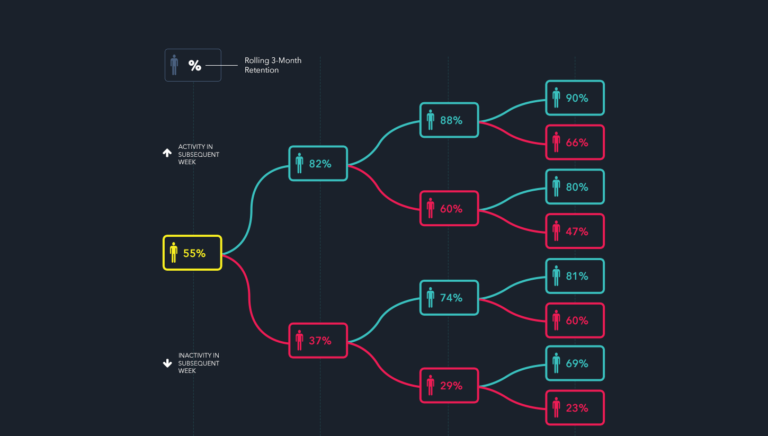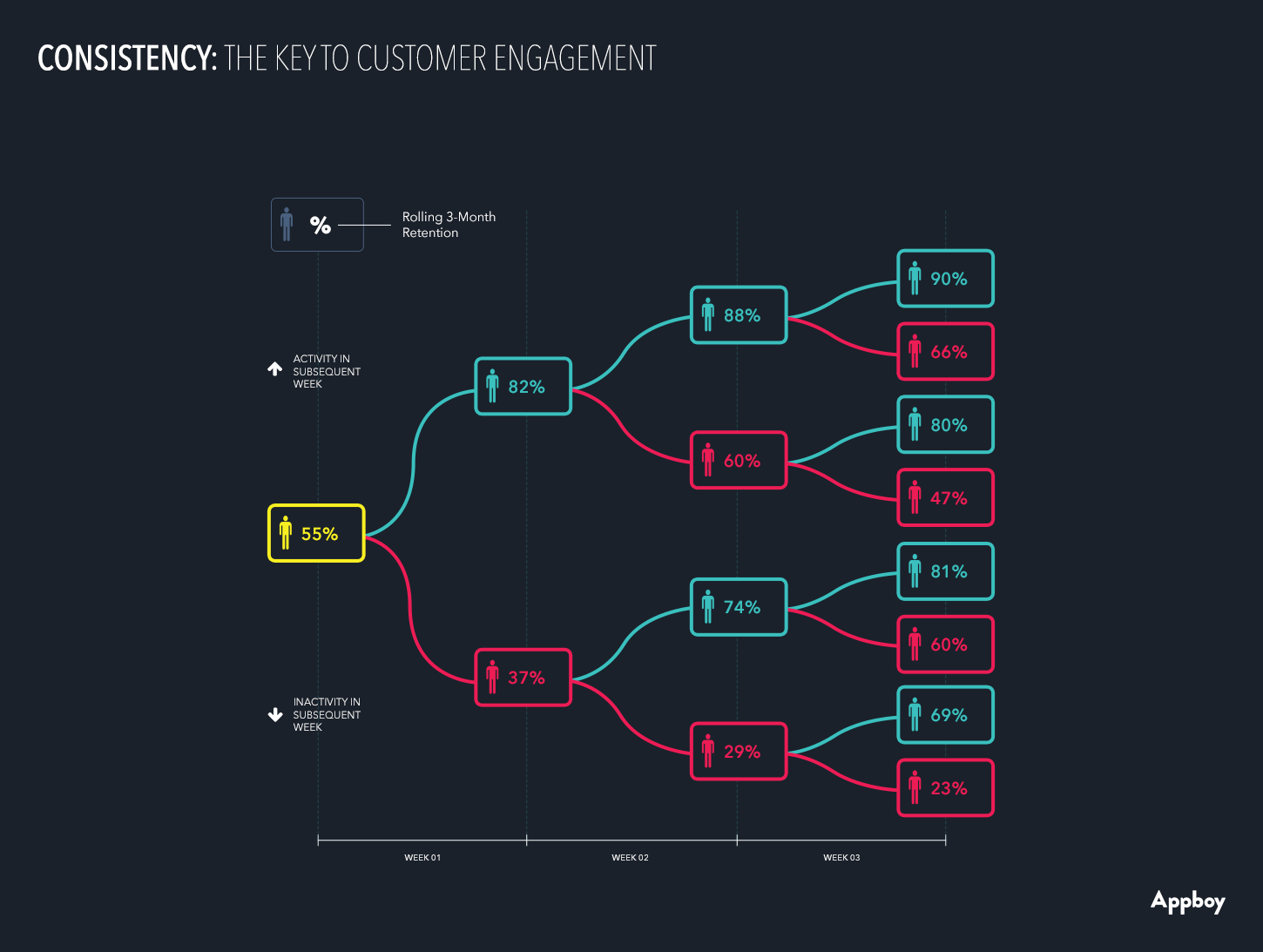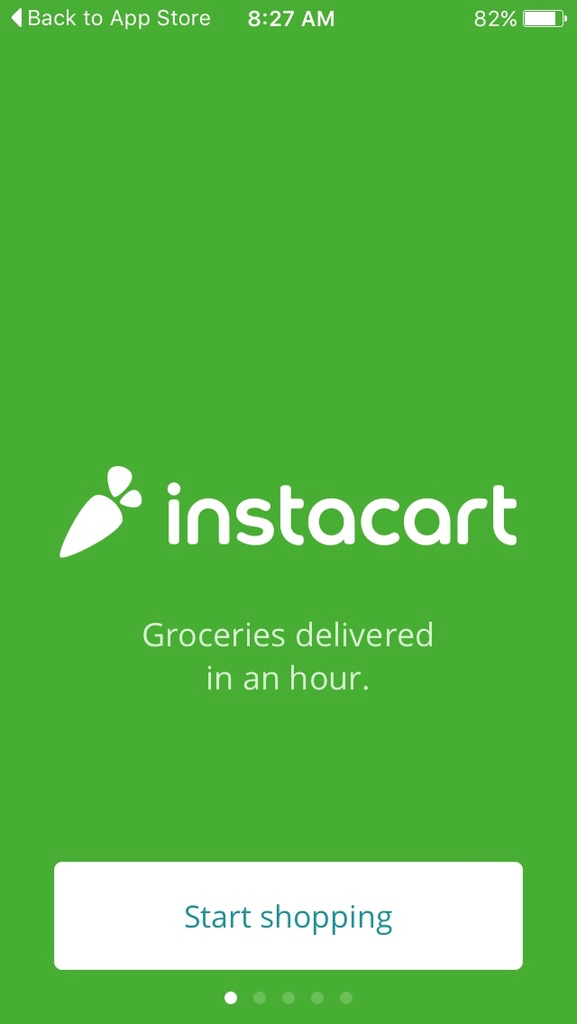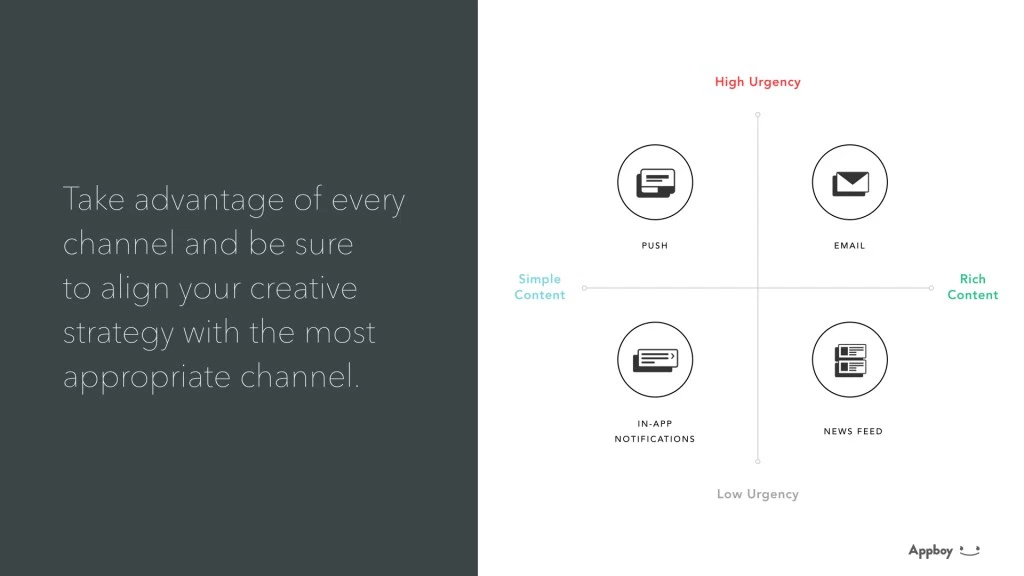At last! You’ve reached your user acquisition goal, the monkey is finally off your back, and the light at the end of the tunnel is here. You’re firmly on your way to being the next big app. You breathe a sigh of relief, but before you can finish exhaling, you feel the crushing weight of a gorilla and the light recedes into the distance. I apologize for the idioms, but this point deserves emphasis: acquiring users is only the beginning of the arduous and ongoing battle to build and maintain your user base. Engaging users beyond the initial download is a daunting task, requiring significant investment and a concentrated and deliberate focus. This guide will provide figures, metrics, tools and tips to make your engagement challenge seem a little less formidable, or hopefully a lot.
What is Mobile App Engagement and Why is it Important?
According to Braze, engagement is the “process of actively building, nurturing, and managing relationships with customers,” ultimately driving customer loyalty and growing the lifetime value of each customer. Re-engagement is reviving the lapsing, inactive, or churned users to return to the app and resume higher levels of engagement. With the majority of apps being free to download, a download is merely an expression of interest and does not guarantee in-app purchases, continued use of the app, or even taking steps in the onboarding process. In fact, data from Localytics shows that 23% of users abandon an app after just one use and 62% of users will use an app less than 11 times. And time is of the essence in the battle to turn downloads into retained users.
Clearly app engagement is hard, but what exactly is the value of an engaged user? Why not just acquire more users? Forbes estimates that it is 6 or 7 times more costly to acquire a new user than retain an existing one, and this cost is rising. Moreover, the traditional marketing funnel (Awareness, Interest, Desire, Action) has become outdated in the mobile app space. Engagement is no longer a linear path with a single endpoint, but rather a dynamic cycle of ongoing interaction with many touch points. Engaged users are more likely to make in-app purchases, recommend the app to friends or family, provide feedback, and remain loyal to your brand in a vast sea of apps. That’s a whole lot of value.
How Should Engagement be Measured?
There is no single metric that adequately encapsulates every facet of user engagement. Engagement spans many stages of the customer lifecycle and means different things to different companies. With retail apps, for example, purchases are the ultimate measure of engagement. However, an entertainment app may prioritize the amount of time a user spends in their app or the number of visits. The following metrics are meant merely to be guidelines, it is up to you to decide which metrics and timeframes are relevant and valuable to your app and how to combine them:
- Active Users – daily average percentage of users that opened the app within a certain time period (ie. days, weeks, months, etc)
- Number of Sessions – the number of times the app is opened over a certain period of time
- Session Length – the period of time between a user opening the app and closing it (or until it times out)
- Session Interval – the amount of time between app sessions (ie. the frequency of app visits)
- Time in App – the amount of time spent in the app over a period of time
- Screenflow – how users navigate through your app including screen exits, screen visits, and screen-to-screen flow
- Retention Rate – percentage of users who remain active on app between sign-up and a certain time period (days, months, etc)
- Lifetime Value – prediction of the net profit from the entire future relationship with a customer
- Interactions – what percent of users are messaged or prompted to take a certain action and what percent respond or complete that action (ie. give a review, recommend to a friend, etc.)
- Opt-ins/Opt-outs – amount or percentage of users that either sign up for or reject additional alerts or notifications
Start User Engagement Early and Don’t Stop
One of the most common mistakes made in the app marketplace is believing that the main functions of the app itself will keep users coming back again and again. A solid value proposition and product-market fit will only go so far in this increasingly saturated mobile world, in which app engagement is ever-so fleeting. Engagement shouldn’t be a response to user inactivity, but rather a proactive and ongoing strategy that begins even before a user registers for your app. Otherwise, it could already be too late.
Take a look at Braze’s visual below. 55% of individuals who use an app in the first week after download will return to that app in the next three months:
Not very reassuring. If you convince your users to return to your app in week two, that number jumps to a much more appealing 82%. For those that don’t engage with your app in week two, the three month retention rate falls to a meager 37%. These retention trends continue with each passing week, although the marginal benefit that engagement has on retention levels off. So, should you spend big on engagement early and taper it off later? Let’s take a closer look.
Even if users engage weeks one through three, if they fail to do so in week four, the three month retention rate goes from a potential 90% to 66%. And users that failed to engage weeks one through three, but registered activity in week four, jumped from a potential low of 23% to 69%. Continual investment in engagement can prevent significant drop offs or create re-engagement surges. So, remember to engage early and don’t stop.
Onboard Users Effectively
The process of walking users through the registration and function of your app should be easy, right? It’s actually very difficult to make a good first impression, something many apps are finding out the hard way. For example, requiring users to register immediately leads to a 50% drop in your users before they’ve even activated their account. If you can optimize your download to activation flow, you’re already well on your way to improving your initial engagement numbers.
You should keep two overarching themes in mind when designing your onboarding flow: demonstrate your value and don’t overwhelm. It’s not good enough for your app to provide value, you need to communicate that value to the user, and fast. Product features, ease of navigation, and an aesthetically-pleasing interface are all great, but a user won’t experience any of that unless he or she sees inherit personal benefits.
Take a look at Instacart’s opening screen below. Simple, even plain. But it’s to-the-point and relatable. “Groceries delivered in an hour” peaks the interest of any 25-and-up year old who’s scoured the aisles of their local supermarket in search of a specific ingredient or waited in a long checkout line. Many users can easily contextualize that value proposition in their own lives.
The second theme to consider is: don’t overwhelm. For the same reason that most don’t read the entire manual front to back before assembling something, users don’t need to immediately know every product feature, button, or detail of your app. Give them the critical elements and gradually introduce other features. Information presented should be easily digestible and visually-appealing. Keep text to a minimum, engage with images, and guide the user with a natural, exciting flow. Lastly, if your app requires sign-ups, permission requests, or personal info, only ask for what you need and make the process simple. You can even wait for certain permission requests, such as access to their camera or location, until they’re truly required and the user is more likely to directly understand the need. A surefire way to send users running is making them feel like they’re signing their lives away. If you’ve communicated your value effectively, they should want to register or grant permission.
Tools:
-Branch’s custom onboarding feature enables you to provide a personalized welcome to your users and its deep linking technology can route them right to the content that initially engaged them following the onboarding flow.
-MoEngage features a product that optimizes your onboarding flow and engages your users from the beginning.
-Amplitude’s Pathfinder tool helps you discover drop-off points in your onboarding flow and create the best sequence of events.
Differentiate Your Mobile App From the Web Experience
In order for a user to justify using data and storage space, the in-app experience needs to be distinctly different and significantly better than the web experience.
“There should be no extra functions or buttons or text. You don’t have a lot of real estate and you can’t let people get distracted. You need to lead them along one clear path through your app,” said SC Moatti, former Facebook product leader. “If the cost of an error on web is 1X, the cost of a similar error on mobile is 10x.”
Mobile users are raising their expectations and lowering their patience levels when it comes to apps. Beyond its performance, your app should offer features and advantages that aren’t available through the web. Whether that’s deals and promotions, personalized content, more intimate communication channels, app-to-app experiences, or connections to social media, find a way to separate the app from the website in the user’s mind. Take Facebook for example: Facebook’s mobile app has a simple and ever-present navigation bar at the bottom of the page, whereas its mobile webpage has the bar at the top and as soon as you scroll down the newsfeed it disappears. While this feature alone might not convert web browsers, it is a part of the overall enhanced in-app experience that pulls users back.
Tools:
-Branch’s app-to-app experience and content-sharing features are great ways to make your in-app experience stand out. Deep linking technology allows users to easily navigate to meaningful content within your app for optimal engagement.
-Braze offers solutions that allow you to customize rich in-app content without interrupting the user experience.
–Crashlytics is a crash-reporting tool that identifies and analyzes data on performance issues to ensure you are made aware of problems quickly and are provided with insight to respond appropriately.
Be Smart with Push Notifications, Not Pushy
Push notifications are perhaps the most polarizing feature in the app world. Some users loathe these messages that continually pop-up on their screens, considering them annoying and irrelevant. Others find them convenient sources of information and interaction. According to Localytics, users who have enabled push notifications open an app an average of 9.3 more times per month than those who don’t, representing a 171% increase in engagement. And the thirty day retention is increased from 17% to 44%.
Before sending push notifications, it’s important you have devised the best way to encourage users to opt-in. Similar to the onboarding flow, it’s all about communicating value. Simply asking users to enable notifications right off the bat will more than likely lead to an automatic rejection. After you’ve expressed the value of the app itself, tell the user why notifications are essential to the experience. The industry norm for accepting standard push notifications (seen below) is 32%, and remember this varies across industries. MoEngage explains that communicating the value of push notifications in junction with an aesthetically-pleasing request interface can raise the opt-in rate to 50%.
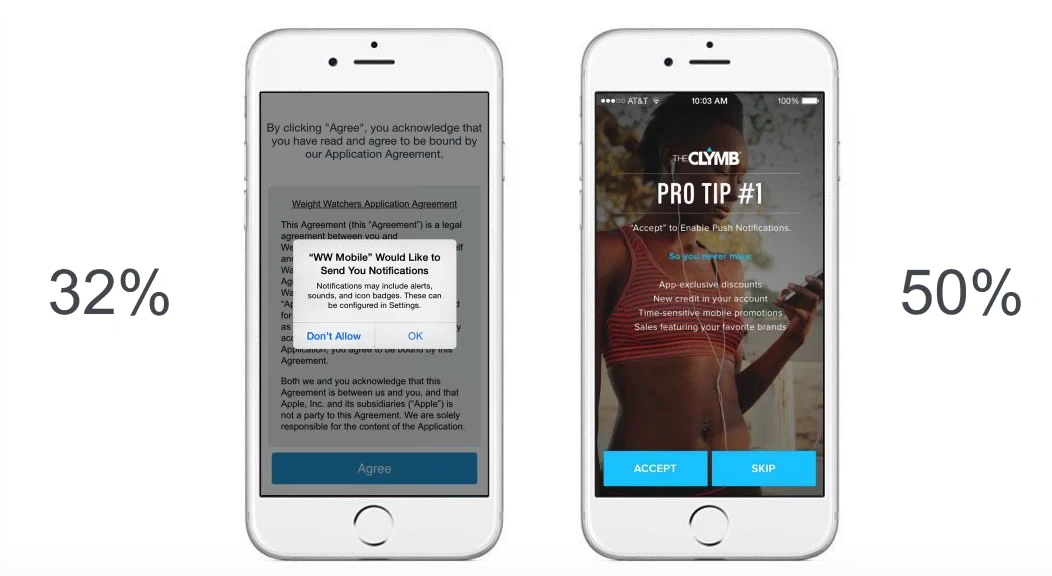
Strive to make push messages as relevant and timely as possible to individual users. Relevance is about personalizing the message based on a user’s behavior within the app. Go beyond just including their name with a standardized message. Analyze how the user navigates within the app, which screens they fall off at, what seems to engage them, and where they are along the customer lifecycle. Using this data, tailor a notification campaign to prompt or incentivize action for your various user groups. Lure back an inactive user with a tempting deal, congratulate a loyal user, or send personalized content to a user with fluctuating engagement. A generic “We miss you” notification doesn’t inspire any action, and may even prompt the user to delete your app all together.
The other factor to consider is timing. Don’t bombard your users with notifications and be considerate of when you send them. Your goal is to establish long term interaction and and associate positively, not to constantly interrupt their day. Be sure that event-based notifications are timed practically. For instance, Cleartrip sends a push notification prompting a user to book a hotel after they’ve purchased a flight. If Cleartrip sent this notification before the user booked the flight or too long after, the user may not feel the same imperative to book the hotel.
Tools:
–Tune
Make In-App Messages Natural and Actionable
In-app messaging can drive a 3.5x high user retention rate. Your in-app messages should follow a similar strategy as your push notifications, but there are a few key differences. Relevance and timeliness still apply, and you want to, of course, continue to provide value with your messages.
However, as the name implies, your users are in your app when they receive these messages, unlike push notifications. Therefore, this tool can only be used to engage, rather than re-engage, and it is pivotal that the user flow is not fragmented or lessened by these messages.
Take advantage of your audience’s attention, but don’t abuse it. Referral SaaSquatch put it perfectly when they said in-app messaging should “feel like a natural extension of the app itself, not additional marketing.” Use these messages to start a dialogue with the user or communicate important information like new features, event-triggered rewards and deals, or engaging content. Make these messages actionable with CTA’s or deep links. You want to drive certain behavior and provide tangible value to the user, not just show them words.
Tools:
–Tune
Foster a Two-Way Dialogue With Your Users
The high level goal of any app is to drive continual engagement from its users. Like any successful long term relationship, albeit this one is between human and technology, an ongoing stream of communication is vital. Push notifications and in-app messages are effective, but the more you can foster a two-way dialogue with your users, the more you’ll learn from your users, the more brand loyalty you’ll build, and the more engagement you’ll drive.
There are a variety of vehicles to help create this dialogue. Reviews and ratings are extremely powerful in driving user acquisition (or a lack thereof), but they also provide a wealth of user-generated feedback that can be used to gauge user loyalty and improve engagement. Feedback on third party sites is more out of your control, yet still incredibly useful in providing insights on what users like and don’t like about your app. On the other hand, you can control when and how feedback is issued within your app or through channels such as email or social media channels. While targeting loyal users can inflate your ratings and reviews to acquire new customers, it doesn’t necessarily help you improve your app for current users. So strive to hear from unhappy users or those who have churned. Set up email surveys to automatically trigger when a user uninstalls or in-app surveys when a user gives a low rating. And, more importantly, communicate to the user that his or her voice is being heard and you’re actively working to improve their experience. In a survey of app users, almost 90% of those who have had a company respond to their feedback reported a greater likelihood of doing business with that brand. If new features are rolled out, let your users know that their feedback helped drive the improvements. The more personalized you can make it the better.
Tools:
–MoEngage allows you to create behavioral triggers to engage with your users and get feedback.
–Localytics provides features to engage your users in personalized cross-channel conversations.
-With Countly, you can send push notifications with app update or app review requests.
–Apptentive is a platform to establish one-on-one dialogues with users and send survey and ratings requests to gather feedback, answer questions, and develop meaningful relationships.
Optimize for Digital Sociability
With the current technological trends and growing millennial influence, digital interactions have become a popular new way of socializing. The more you can ingrain your app into this social fabric, the better chance you’ll have to remain top-of-mind with your user base. The overly-simplified psychology behind all of this is that people like doing what their friends are doing.
Leverage this innate human condition by tightly integrating social media networks into your app or creating your own referral systems, content sharing, and community-based features. Spotify has done a masterful job of this by integrating with Facebook and creating a social music platform, in which you can follow your friends to listen to their playlists and see what they’ve been listening to. This connectivity allows users to interact with each other’s self-generated content and shifts the user-to-app dynamic into a user-to-user dynamic. Spotify has also built up its own network through various features like Charts, in which top played songs are listed, connecting users to popular content as determined by Spotify users. This social connectivity is enormously powerful for creating “stickiness.” When they disengage, users lose more than the functionality of the app, they lose that social connection.
Tools:
-Branch’s referral and content sharing features are powerful tools to drive growth and engagement by adding a social dynamic to your app.
-MoEngage also has its own referral feature that can be connected to specific events or contexts.
Understand Your Users and Leverage the Right Channels
The human attention span is an estimated 8 seconds, and a typical consumer is exposed to 10,000+ marketing messages each day. To stand out in that clutter and resonate with users, make your messaging and app experience as personalized as possible. But first, you must understand your users and what motivates them to open up your app. Monitor their activity and detect where they drop off, how they spend their time, what user stage they are in, etc. The goal is to identify unique user segments and tailor messaging and app experience to fit their characteristics. Braze reports that sending messages to specific segments can increase conversion by 200%.
Take retail as an example. One way to segment users is by consumption occasion, such as the stock up mentality vs. impulse buying. For impulse buyers, tempt them with suggested or related items close to checkout. Or segment geographically by localizing the shopping experience, identifying stores near the customer and offering coupons. Personalizing the user experience is an ongoing process, but as apps become more and more sophisticated, it’ll become harder and harder to remain competitive without a high level of personalization.
The other facet to effectively reaching your users is leveraging the right mix of channels. Depending on the content, certain channels will be far more suitable to communicate through:
Source: Braze
Different segments may favor different channels. For example, mobile gamers who are heavy spenders, are more likely to get their information from gaming sites, highlighting the need for a heavy digital presence early in the game’s lifecycle such as targeted ads and PR. On the other hand, light spenders rely more on recommendations of those close to them, so in-game referrals can be a powerful tool. This multi-channel approach should be used throughout the user journey, from acquisitional strategies to onboarding and re-engagement techniques. And remember, email is still a strong communication channel, especially to re-engage users who are close to churning.
Tools: Branch’s Journeys, Universal Email, and content analytics drive engagement across multiple channels and keep track of what content is receiving the most interest. Other tools that can enhance your multi-channel strategy include MoEngage, Braze, Leanplum, and Tune. To better understand your users and their behavior in order to draw actionable insights, the following analytical tools are available: Answers, Crashlytics, MoEngage, Braze, Localytics, Amplitude, Countly, App Annie, Leanplum, Tune, Mixpanel, Facebook Analytics, Google Analytics
So, there you have it, your ultimate guide to improving user engagement. It’s now time to start applying these techniques and using these tools to engage and retain your users past their initial download. Engagement is at the root of the long term success of your app, so adopt a proactive approach to ensuring that acquired users become consistent and loyal ones. This will give your app the best chance to succeed.






















